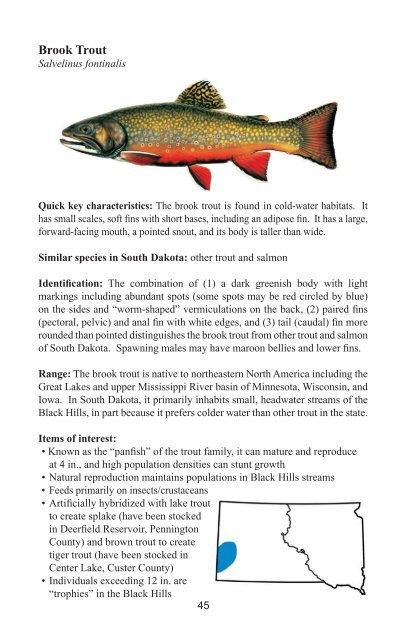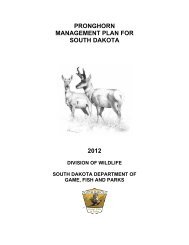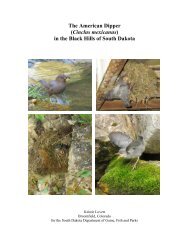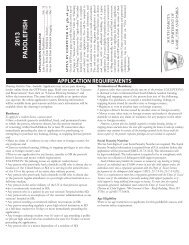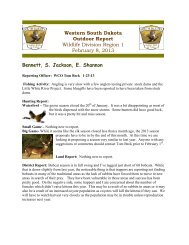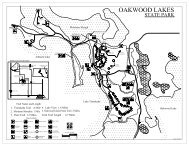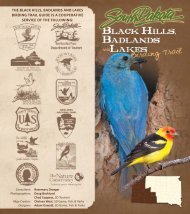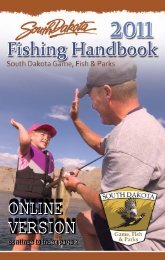pdf version - South Dakota Department of Game, Fish and Parks
pdf version - South Dakota Department of Game, Fish and Parks
pdf version - South Dakota Department of Game, Fish and Parks
You also want an ePaper? Increase the reach of your titles
YUMPU automatically turns print PDFs into web optimized ePapers that Google loves.
Brook Trout<br />
Salvelinus fontinalis<br />
Quick key characteristics: The brook trout is found in cold-water habitats. It<br />
has small scales, s<strong>of</strong>t fi ns with short bases, including an adipose fi n. It has a large,<br />
forward-facing mouth, a pointed snout, <strong>and</strong> its body is taller than wide.<br />
Similar species in <strong>South</strong> <strong>Dakota</strong>: other trout <strong>and</strong> salmon<br />
Identifi cation: The combination <strong>of</strong> (1) a dark greenish body with light<br />
markings including abundant spots (some spots may be red circled by blue)<br />
on the sides <strong>and</strong> “worm-shaped” vermiculations on the back, (2) paired fi ns<br />
(pectoral, pelvic) <strong>and</strong> anal fi n with white edges, <strong>and</strong> (3) tail (caudal) fi n more<br />
rounded than pointed distinguishes the brook trout from other trout <strong>and</strong> salmon<br />
<strong>of</strong> <strong>South</strong> <strong>Dakota</strong>. Spawning males may have maroon bellies <strong>and</strong> lower fi ns.<br />
Range: The brook trout is native to northeastern North America including the<br />
Great Lakes <strong>and</strong> upper Mississippi River basin <strong>of</strong> Minnesota, Wisconsin, <strong>and</strong><br />
Iowa. In <strong>South</strong> <strong>Dakota</strong>, it primarily inhabits small, headwater streams <strong>of</strong> the<br />
Black Hills, in part because it prefers colder water than other trout in the state.<br />
Items <strong>of</strong> interest:<br />
• Known as the “panfi sh” <strong>of</strong> the trout family, it can mature <strong>and</strong> reproduce<br />
at 4 in., <strong>and</strong> high population densities can stunt growth<br />
• Natural reproduction maintains populations in Black Hills streams<br />
• Feeds primarily on insects/crustaceans<br />
• Artifi cially hybridized with lake trout<br />
to create splake (have been stocked<br />
in Deerfi eld Reservoir, Pennington<br />
County) <strong>and</strong> brown trout to create<br />
tiger trout (have been stocked in<br />
Center Lake, Custer County)<br />
• Individuals exceeding 12 in. are<br />
“trophies” in the Black Hills<br />
45


